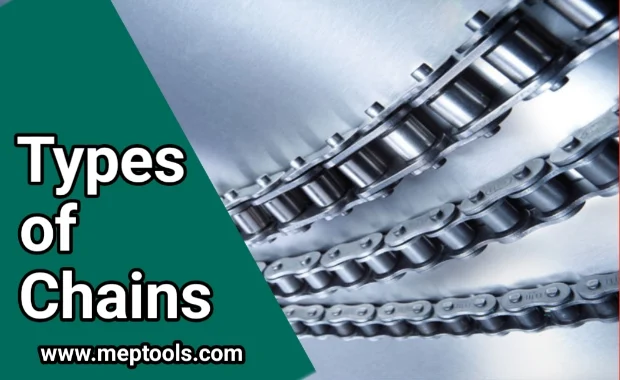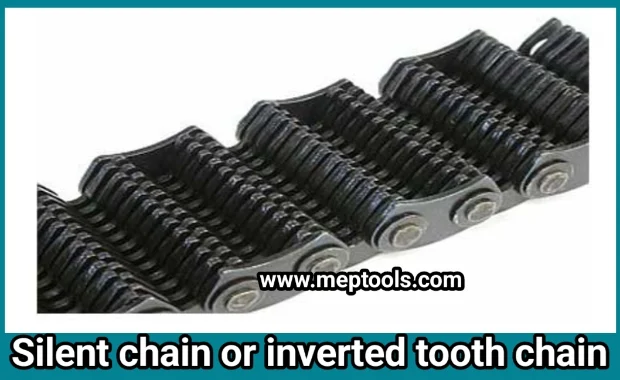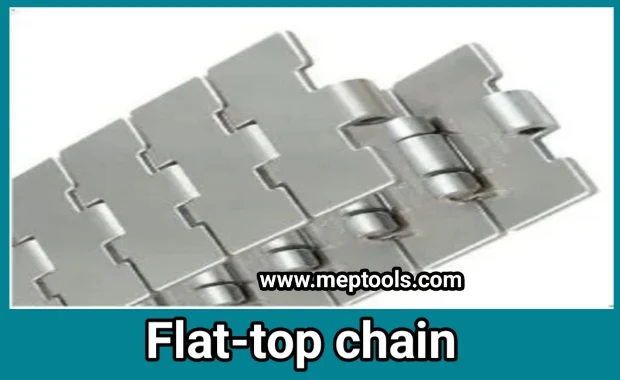Types of Chains in Use
There are many types of chains used in chain drives, each with its own advantages and disadvantages. The five most common types in use are as follows:
1. Roller chain (bush roller chain)
2. Silent chain or inverted tooth chain
3. Leaf chain
4. Flat-top chain
5. Engineering steel chain
Roller chain
When talking about chains, roller chain is probably the one that comes into most people’s minds. Roller or bush roller chains are widely used for power transmission in bicycles, motorcycles and other applications in the transportation industry. They are usually made from plain carbon steel or from steel alloys.
A roller chain is made up of an inner plate (roller link plate), outer plate (pin link plate), bushes, pins and rollers. The rollers are placed equidistantly between chain links. These rollers engage with the sprocket teeth and transfer power through the chain. An important advantage of roller chains is that they rotate as needed when they come into contact with the sprocket teeth, thus reducing power losses.
In transmission chains, the height of the roller chain link plates (on each side of the roller) is greater than the rollers. This prevents the side plates from making contact with the sprocket during operation. In addition to that, they also act as guides and prevent the roller chain from slipping off.
For roller chains in conveyors, the roller diameter is relatively larger than the height of the sidebars. This prevents contact between the sidebars and the conveyor track and improves efficiency by eliminating translational friction. Larger rollers also reduce rotational friction.
For greater power requirements, designers can opt for multi-strand roller chains. Having multiple strands permits the use of low speeds and small chain pitches for the same load requirements.
Silent chain (inverted tooth chain)
Most chain drives are infamous for their high operational noise. In noise-sensitive environments such as enclosed spaces, mines and residential areas, a quieter chain is more suitable. This keeps the disturbance to the surrounding environment under control and promotes worker well-being.
Enter silent chains, also known as inverted tooth chains. A silent chain can transmit large amounts of power at high speeds while maintaining a quiet operation. The chain consists of flat plates stacked in rows and connected through one or more pins. Each link has the contour of sprocket gear teeth on the underside where it engages with the sprocket teeth.
The load capacity for a silent chain increases with the number of flat plates in each link, and so does the tensile strength and the chain width.
Leaf chain
These are the simplest types of chains in use. They consist only of pins and link plates. The link plates are alternated as a pin link and an articulated link. They don’t mesh with sprocket teeth as leaf chains are designed to run over sheaves for guidance.
Leaf chains find use in lifting and counterbalancing applications. Some common examples of applications using leaf chains are lifts, lift trucks, forklifts, straddle carriers and lift masts. In all of these low-speed machines, the lift’s chain endures high static loads and a small amount of working load. Leaf chains can handle shock and inertia better than other chain designs.
All lift chains must be capable of handling high tensile stresses without elongating or breaking. They must have sufficient ductility to endure fatigue. As always, lubrication and service environment must be given their due thought already in the design process.
Flat-top chain
Flat-top chains are intended only for conveying. They can replace conveyor belts and belt drives as the material can be carried directly on its links. An individual link is usually made out of a steel plate with barrel-shaped hollow protrusions on its bottom side. The links are connected to preceding and succeeding links by passing a pin through these protrusions underneath the links. The nature of these joints allows movement only in one direction.
There are special types of flat-top chains that can flex sideways. The pin construction permits sideways movement in both directions to enable the conveyor chain to go around curves.
Flat-top chains are used in low-speed conveyor machines for material transportation in assembly lines.
Engineering steel chain
The engineering steel chain has been around since the 1880s. This chain was designed to handle the toughest environments and the most demanding applications. They were made of hot-rolled steel and sometimes heat-treated for extra strength.
Engineering steel chains are just as relevant today. However, their strength, wear rate, loading capacity and pitch have increased to match present-day industrial needs.
These chains consist of links and pin joints. The clearance between this chain’s components is larger than other chains as it has to handle dust, dirt and abrasives under normal operating conditions.
Most engineering steel chains function as conveyor chains for material handling but some are also used in drives. They can be seen in applications such as conveyors, forklifts, bucket elevators and oil drilling machines.












![FREE Irrigation autocad blocks download [DWG] | MEP Tools](https://blogger.googleusercontent.com/img/b/R29vZ2xl/AVvXsEiV-RdjuRHRfloSECetjct_jqOzVmfLzlsj4cD1PO1I24x5bgvkHljsqtbzRMVt3ZEEp_3obsS2JfAtW9s3PpKRFdM84uFpb9giOFjFnB0Swn1it4Un9HJrzme5f1KH2Kczfe7KHb-nU01Iob8kFKT8xLo3qyPsiPl8exQBh7BnqPRZksvoXsb_tVJj85Y/w72-h72-p-k-no-nu/FREE%20Irrigation%20autocad%20blocks%20download.jpg)



0 Comments